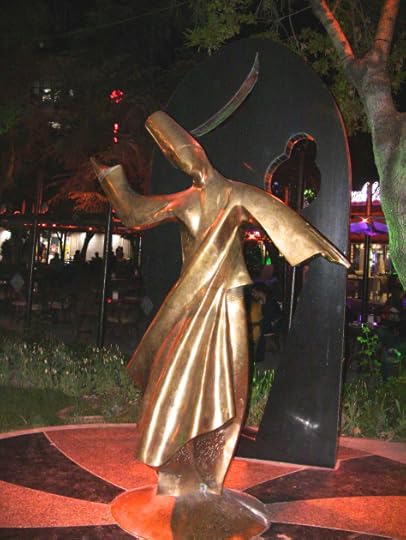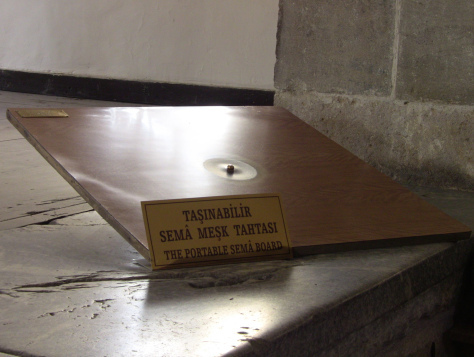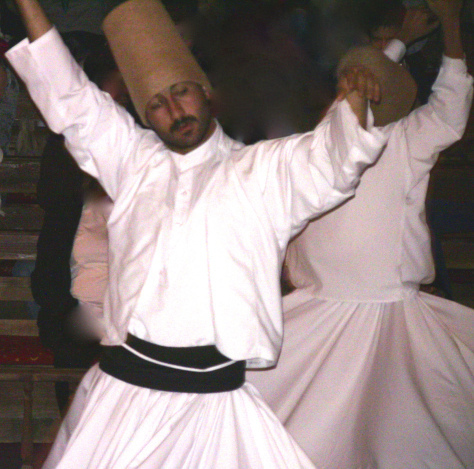To Be Entranced
Pause a moment to wonder about the purpose of a Sema Board. Here’s a hint: the board is approximately three foot square.
A manhole cover? The lid for a very large flour bin? A decorative wall panel?
I cannot even say myself, for certain, but I have the benefit of context and so can guess. I saw the Sema Board in the Mevlana Museum in Konya, Turkey, home of the the mausoleum of Jalal ad-Din Muhammad Rumi, a Persian Sufi mystic. Rumi was also known as Mevlana, the founder of the Mevlevi order of whirling dervishes.
Now can you guess?
It is said that one day Rumi was walking through the marketplace and heard the hammering of the goldbeaters. The sound was rhythmic; the hammers, to Rumi’s ear, were beating the dhikr, or Arabic rosary. It made him so happy that he stretched out his arms and started spinning.
 The Order of the Whirling Dervishes believes that the fundamental condition of our existence is to revolve. Scientifically, they are probably right. From electrons on up, it is easy to find examples of circular cycles: in chemistry, astronomy, biology, physics, history and our own lives. And yet we often carve out linear paths for ourselves. Could losing ourselves in the choreography of the cosmos be helpful?
The Order of the Whirling Dervishes believes that the fundamental condition of our existence is to revolve. Scientifically, they are probably right. From electrons on up, it is easy to find examples of circular cycles: in chemistry, astronomy, biology, physics, history and our own lives. And yet we often carve out linear paths for ourselves. Could losing ourselves in the choreography of the cosmos be helpful?
The mystic nature of the whirling dervishes was not acceptable to all, and in 1925, as part of new secularization policies, the Turkish government outlawed the practice. As is often the case in such situations, adherents kept the practice alive in secret. Thirty years later the restrictions were eased, and in the 1990’s lifted. In 2005, UNESCO proclaimed the Mevlevi Sema Ceremony of Turkey one of the Masterpieces of the Oral and Intangible Heritage of Humanity.
Several elements of the Sema Ceremony continue to whirl in my head. I offer them for your perusal, in linear form complete with bullet points, my preferred methodology for managing ideas that otherwise cause chaos.
In Rumi’s time, those wishing to become dervishes were given a cushion in a corner of the kitchen, which is where training took place. They stayed on the cushion for two full days, eating and sleeping in place, watching the training without participation before deciding whether to continue. I have never contemplated a life change so assiduously.
Training lasted a magical 1,001 days.
At the end of each of the four movements (selams) of the dance, the dervishes stop whirling. Each whirler crosses his arms over his heart and pairs with another whirler. Shoulder to shoulder, hip to hip, the two press into one another, ostensibly to steady themselves. But the symbolism of this connection resonates with me even more than the dance itself.
Masterpiece of the Oral and Intangible Heritage of Humanity? Check out UNESCO’s website. I love the idea that there is recognition for the intangible, for soul.
A whirling dervish rotates on his left foot, using his right to push his body around the heart in a counter-clockwise direction. The whirler is meant to keep his eyes open but unfocused, allowing images to flow and blur. This is in direct contradiction to my daughter’s ballet training and the focused spotting required for pirouettes. Although I did not see this in practice, my guess is that the nail in the Sema Board helps anchor the left foot, connecting it to the ground while the world revolves crazily in front of the eyes.
I found a flat rock embedded in my patio and gave whirling a try. Without focus, I felt nauseous and disoriented. My perspective was skewed and I staggered as if drunk on the “choreography of the cosmos.” So I ask myself, when was the last time I was comfortable whirling? My father’s airplane rides? On an ice rink? Playing crack the whip?
When was the last time I could let go and be totally entranced?







